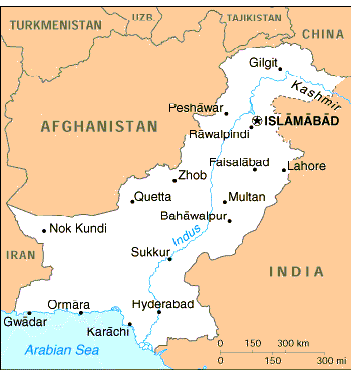|
 Pakistan's neighbours are an eclectic and
ornery bunch: Iran to the
south-west; Afghanistan to
the west and north; China
to the north-east; and India
stretching down its eastern side. The southern coast abuts the Arabian Sea. The country is composed of towering peaks
in the north (including the second-highest mountain in the world,
8611m/28,245ft K2), dry and scrubby
mountains in the west, an inhospitable plateau in the south-west, barren
deserts in the south-east and alluvial plains everywhere else. These plains,
constituting about a third of the country, are Pakistan's `heart', where most of
its people live and most of its food is grown. Coursing through all this
tumult is the Indus River, which falls from Tibet
then travels 2500km (1550mi) south before emptying through an immense delta
into the Arabian Sea. Natural fauna in Pakistan's
lowlands is patchy - mostly scattered clumps of grass and stunted woodlands.
However, as the landscape rises, there are quite large coniferous forests and
carpeted slopes of multicoloured flowers in the northern mountains. Fauna
includes bear, snow leopard, deer and jackal. Pakistan's
800km (500mi) of coastline teems with shark, shellfish and sea turtle, while
the Indus delta is home to the marsh
crocodile. Pakistan
has three seasons: cool (October through February); hot (March through June);
and wet (July through September). There are, however, big regional
variations. In the south, the cool season brings dry days and cool nights,
while the northern mountains get drizzle and plummeting night-time
temperatures. The hot season means suffocatingly hot and humid conditions in
the south but pleasant temperatures northwards. During the wet season, the
tail end of the monsoon dumps steady rain mostly in the narrow belt of the
Punjab from Lahore to Islamabad. But further north, the high
mountains block all but the most determined clouds, which means relatively
little rain falls there (budding trekkers please take note). Pakistan's neighbours are an eclectic and
ornery bunch: Iran to the
south-west; Afghanistan to
the west and north; China
to the north-east; and India
stretching down its eastern side. The southern coast abuts the Arabian Sea. The country is composed of towering peaks
in the north (including the second-highest mountain in the world,
8611m/28,245ft K2), dry and scrubby
mountains in the west, an inhospitable plateau in the south-west, barren
deserts in the south-east and alluvial plains everywhere else. These plains,
constituting about a third of the country, are Pakistan's `heart', where most of
its people live and most of its food is grown. Coursing through all this
tumult is the Indus River, which falls from Tibet
then travels 2500km (1550mi) south before emptying through an immense delta
into the Arabian Sea. Natural fauna in Pakistan's
lowlands is patchy - mostly scattered clumps of grass and stunted woodlands.
However, as the landscape rises, there are quite large coniferous forests and
carpeted slopes of multicoloured flowers in the northern mountains. Fauna
includes bear, snow leopard, deer and jackal. Pakistan's
800km (500mi) of coastline teems with shark, shellfish and sea turtle, while
the Indus delta is home to the marsh
crocodile. Pakistan
has three seasons: cool (October through February); hot (March through June);
and wet (July through September). There are, however, big regional
variations. In the south, the cool season brings dry days and cool nights,
while the northern mountains get drizzle and plummeting night-time
temperatures. The hot season means suffocatingly hot and humid conditions in
the south but pleasant temperatures northwards. During the wet season, the
tail end of the monsoon dumps steady rain mostly in the narrow belt of the
Punjab from Lahore to Islamabad. But further north, the high
mountains block all but the most determined clouds, which means relatively
little rain falls there (budding trekkers please take note).
|